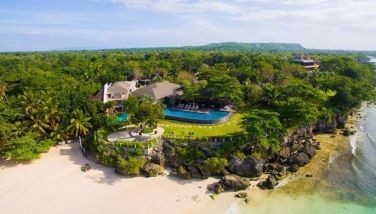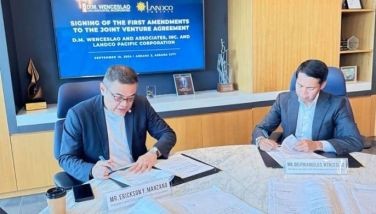Metro Manila is dangerously crowded

The Metro Manila urban area, according to a World Bank study, is one of the densest in the region. It is also becoming even denser.
Why does that matter? Two things make that matter. It makes the quality of life for its inhabitants worse with every passing year. It also makes for unimaginable consequences, if a big calamity strikes.
I hate to be gruesome, but sometimes I think we need a big earthquake to give us the resolve to fix things, but that comes with a huge cost in lives. Indeed, a catastrophic tremor will likely seriously damage, if not bring down older structures.
Every time I fly in or out of Metro Manila, it is so clear from the air how despicably chaotic it is down there. No zoning or land use policies in effect and the congestion in its arteries of roads paint a picture of a city on the verge of paralysis.
What happened in Metro Manila is the result of poor governance through the years. Perhaps it all started after the city was pulverized by the Americans and the Japanese during WW 2. We were left to pick up the pieces and remake our lives as creatively as we can amidst war debris.
The Liberation mentality never left us. Just look at the jeepney, the public transportation born out of necessity from Army surplus jeeps, it is still here 70 years after. What was makeshift or intended to be temporary became permanent out of necessity and laziness on the part of leaders and people.
The last few weeks, our attention was focused on Metro Manila’s traffic jams. Of course, there is nothing really much we can do now for the short term beyond fielding armed constabulary officers to instill discipline among drivers. But that’s more PR for an inept regime than anything else.
Even the long term solutions will likely not happen due to a combination of lethargy and absence of strong political will to make the tough decisions. There is, for instance, no going around the need to reduce the metro area’s population density. It is just too dangerous to keep all those souls crowding in an area that’s prone to natural calamities.
I am glad that because the congestion problem is now more than an annoyance in our lives, there is open discussion of my favorite topic: how to govern the metro area. We cannot go on allowing those 17 mayors of Metro Manila cities to continue ruling their fiefdoms as their family businesses. We need a metro perspective.
The World Bank points out the Manila urban area is notable not just for its size and density, but also for its extreme administrative fragmentation. Mindless growth and poor governance have aggravated urban blight and made it difficult to have more inclusive economic growth.
Yet, the World Bank points out, “urbanization is a key process in ending extreme poverty and boosting shared prosperity.” But even as urban growth provides opportunities for the poor, the Bank warns, it can also aggravate existing inequalities in access to services, employment, and housing.
This is why better regional planning is a must. “Spatial planning can help reduce inequality in access to urban opportunities and amenities. The pattern of urban form is one of many factors that affect the ability of the urban poor to access economic opportunities in their cities.
“Ensuring a spatial match between jobs, affordable retail, public transportation, health and education services, recreational areas, and affordable housing is one of the means of fostering such access. Risk-sensitive land use planning can ensure that urban growth does not expose the urban poor to natural disasters.”
On that basis, I think Metro Manila is a hopeless case. We have to start more or less from scratch, learning from the mistakes we have committed in our National Capital Region.
In any case, it is now too late to impose any sensible spatial planning in Metro Manila. It is even impossible to expropriate enough land to build a new runway for NAIA, which is a less ambitious project.
This is why the offer of BCDA to put up a “backup government center” at Clark’s Green City should be taken seriously. It is the right strategy to take in conjunction with our disaster preparedness plan for Metro Manila. It also could be the start of an effort to move government offices and inevitably, people away from the crowded Metro Manila area.
According to Arnel Casanova, BCDA president and chief executive, they have offered free lots inside the Clark Green City for government agencies to use in establishing backup offices. These will ensure uninterrupted delivery of services in the aftermath of major calamities.
Green City is a 9,450-hectare metropolis to rise within the Clark Freeport Zone whose development was recently won by the Filinvest Group. It is expected to be the first smart, disaster-resilient city in the Philippines.
Clark Green City is around 100 kilometers from the West Valley Fault Line and is surrounded by the typhoon-mitigating Zambales and Sierra Madre mountain ranges.
For now, BCDA made the offer to prepare for the eventuality of a big earthquake in Metro Manila’s West Valley Fault. “When the Big One strikes, delivery of government services and operations of businesses suffer the longest because you will have to face issues of health or personnel shortage, supply chain problems, public order, and a host of other challenges,” Cassanova said.
But really, Clark is a good area to build a new government center, our version of Malaysia’s Putrajaya. A new large center of population in Clark can be jumpstarted, if government initiates the move.
Perhaps, the government buildings can be constructed by the developer, Filinvest, along the lines of the DepEd partnership with the private sector for constructing school buildings. Government budgets for rent and upkeep of Manila-based offices can be used to amortize the cost of new buildings in Green City.
Moving government offices to Clark will also solve the NAIA congestion problem. Flights will no longer have to crowd limited slots at NAIA because there will also be rising demand to fly directly in or out of Clark.
But one thing we have to watch out for is the haphazard development of the adjoining San Fernando-Angeles urban center, something already evident. It will be easy to do things right at Green City, but complementary efforts must be made for the adjoining areas.
Why do we have to move now on this worsening problem of Metro Manila congestion? Simply because doing nothing may make the situation explosive over time as life, specially among the urban poor, becomes more and more oppressive.
The findings in this World Bank study reinforce the connection between economic growth and urbanization. But how a city expands directly affects the poor.
Getting urban form, density, and administrative coordination right, the World Bank says, will be essential to ensuring that urbanization helps achieve the twin goals of ending extreme poverty and boosting shared prosperity.
We have this golden opportunity to try something we really ought to be doing anyway by working with BCDA in Clark. Once Clark itself gets built up, we will lose the chance to have a national capital that is done right.
Indeed, we should not wait for the Big One to happen. Once a massive earthquake devastates Metro Manila to make it nearly uninhabitable, we may no longer have the massive land area now available in Clark to build a new National Capital from scratch.
In any case, Metro Manila will be increasingly uninhabitable too even without an earthquake. Climate change may make more than half of the metro area extremely flood prone, if not permanently under water. I saw some maps simulating what could happen and it isn’t pretty.
I realize we have a lot of current problems that keep us preoccupied. But someone in authority must step up and execute a viable plan to reduce population density in Metro Manila. I don’t think we can wait.
I hope this issue gets discussed during the campaign, but I doubt it. I hope the next administration will start the ball rolling so future generations can have a better life. It looks like an impossible task, but to do nothing is worse.
I suggest that BCDA be made to jumpstart that program on behalf of government. I am confident its very competent management today can get the job done. We have no more time to lose and I think BCDA is ready to go right now, in case P-Noy wants to do something significant.
Boo Chanco’s e-mail address is [email protected]. Follow him on Twitter @boochanco
- Latest
- Trending


























